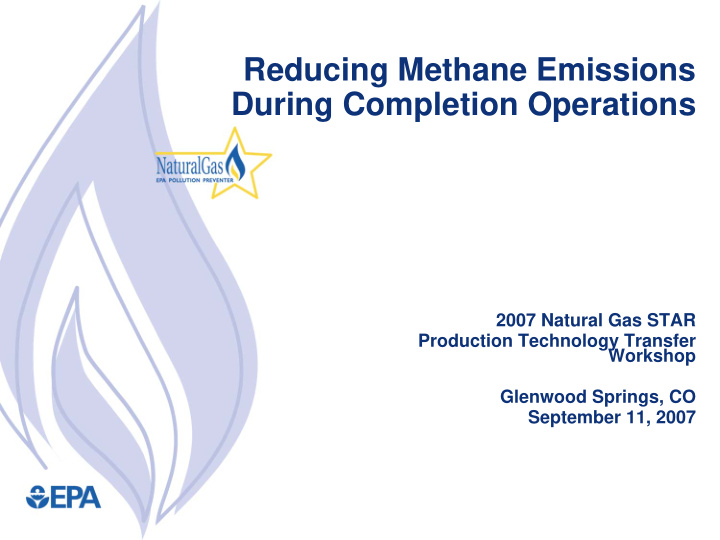



Reducing Methane Emissions During Completion Operations 2007 Natural Gas STAR Production Technology Transfer Workshop Glenwood Springs, CO September 11, 2007
Reducing Methane Emissions during Completion Operations Williams Production RMT – Piceance Basin Operations Agenda Objectives Piceance Basin Well Completion Process Description Equipment Needed Economics Conclusion
Objectives: Virtually eliminate venting of natural gas produced during new well completions. Capture produced gas and deliver to sales. Meter produced gas for revenue distributions. Ensure safety of personnel during entire process.
Piceance Basin Well Completions Williams Fork Formation – low permeability, tight, lenticular sandstone 10-acre Spacing Wells drilled to depths of 6,500 ft to 9,000 ft. Reservoir pressures as high as 4000 psi. Fracture stimulation required to make wells economical. Typically fracture stimulate 5 to 6 separate stages per well.
Piceance Basin Well Completions Perforate casing prior to Stage 1 – makes fracture stimulation possible Fracture Stimulate Stage 1. Flowback until next step. Shut in well. Set flow-through casing plug to isolate next stage to be fracture stimulated. REPEAT for each stage (avg. 5 to 6 stages/well) Well continues to produce through the flow-through plugs until a workover rig is available to drill out the plugs. Stimulation fluids and gas are produced while plugs are drilled out.
Sand Flowback Problems WASHOUT
Green Completions Technology used to recover gas would otherwise be vented or flared during the completion phase of natural gas well. Williams designed equipment to handle high pressure, high rate flowback fluids so as to safely handle and to sell the natural gas produced during flowback period. Flowback equipment is used to separate sand, water and gas during initial flowback.
Gas Vessel Sand Vessel Flowback Unit
Flowback Unit - Operation Sand Vessel separates sand from flowback liquids. Sand is dumped to reserve pit. Gas and Liquids dump to the Gas Vessel.
Flowback Unit - Operation Gas Vessel separates gas from water used for fracture stimulation. Gas routed to sales line through the production equipment to insure proper metering. Water dumps to holding tanks Water is recycled and reused for subsequent fracture stimulation jobs. Flowback Unit vessels operate at 275 to 300 psi.
Risks Safety – Primary Concern High pressure gas, liquids and sand can erode steel pipe. To mitigate safety concerns: Pipe, Fittings and Vessels use high strength metal Flowback Units are monitored 24/7.
Completion Production Simultaneous Operations Drillout Drilling
Risks Operations & Reservoir Risks Fluids pumped downhole must be recovered as quickly as possible Wellbore damage by fluids can diminish production Flowing fluids to flowback skid results in decreased flowback rates because of high backpressure (versus no backpressure when venting)
Economics – Volume Recovered No. of Spuds Actual Total Not Actual Flowback Flowback Actual Number Completion Number of Completed or Completion Gas Gas Year of Flowback Gas Well Completed Gas Generated Recovered Recovered Completions Vented/Flared Spuds Without (MMCF) (MMCF) (%) (MMCF) Flowback 2002 75 29 46 794 307 487 61.3% 2003 78 2 76 1227 31 1196 97.5% 2004 251 10 241 5060 202 4858 96.0% 2005 307 32 275 8070 841 7229 89.6% 2006 466 40 426 10863 932 9931 91.4% Totals 1177 113 1064 26014 2313 23701 91.1%
Economics – Volume Recovered Williams Production Piceance Basin Completion Gas Recovered 12000 100.0% 10000 90.0% Percent Gas Recovered, % 8000 MMCF 6000 80.0% 4000 70.0% 2000 0 60.0% 2002 2003 2004 2005 2006 Completion Gas Produced Percent Gas Recovered
Economics – Savings Realized Flowback Revenue/Cost Analysis Year Total Recovery Cost Net Savings Revenue (MM$) (M$) (MM$) 2002 1.75 0.22 1.53 2003 7.20 0.90 6.30 2004 36.46 2.85 33.61 2005 48.73 4.85 43.88 2006 64.99 8.59 56.40 Totals 159.13 17.41 141.72
Economics – Savings Realized Williams Production Piceance Basin Completion Gas Recovered 30000 Target Opportunity to get the remaining completion gas captured 25000 and sold. 20000 MMCF 15000 Without Green Completions an estimated 23 BCF of completion 10000 gas has been recovered and sold since 2002. 5000 0 2002 2003 2004 2005 2006 Total Completion Gas, MMCF Estimated Completion Gas Recovered (No Improvement), MMCF
Capturing Gas During Drillouts Typically gas is vented/flared during drillout procedure Solution: modular flowback packaged unit (Weatherford or Pure Energy) Example drillout: 3,000-psi shut-in pressure 1,400-psi drawdown while drilling 8-12 hours for plug drill out time 5,000 -15,000 MCF venting each drillout
Conclusion Reduces methane emissions, a potent Green House Gas (GHG) Well completion type location and existing infrastructure determine viability of Green Completion Technologies Produced water and stimulation fluids from green completions are recycled Reduces emissions, noise and citizen complaints associated with venting or flaring Increases Economic Value Added
Contacts John Gardner Williams (303) 572-8413 john.gardner@williams.com Robert Vincent Williams (970) 263-2702 robert.vincent@williams.com
Recommend
More recommend